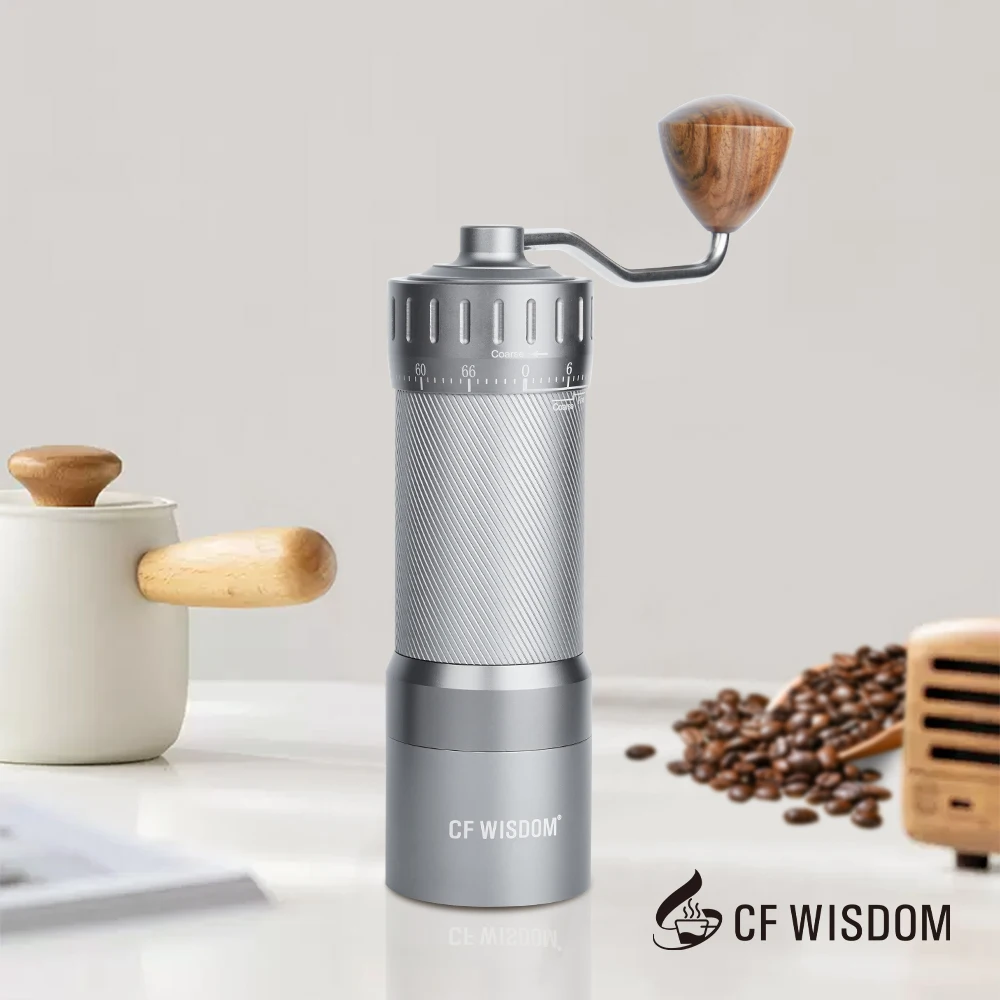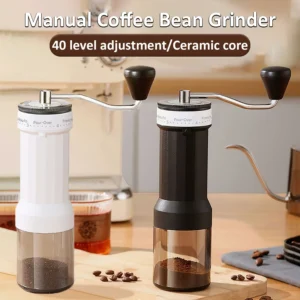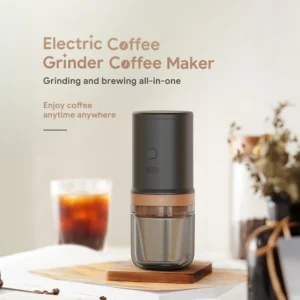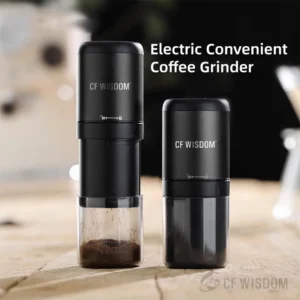The Unrivaled Joy of Freshly Ground Coffee in the Great Outdoors
Picture this: dawn breaks over misty mountains, birds begin their morning chorus, and you unzip your tent to greet the day. What could enhance this perfect moment? The rich, intoxicating aroma of freshly ground coffee beans wafting through the crisp mountain air.
There’s something magical about brewing coffee outdoors that elevates the entire camping experience. But not just any coffee will do. The difference between pre-ground and freshly ground beans is night and day—especially in the wilderness where simple pleasures become profound experiences.
When coffee is ground, the beans release volatile compounds that begin evaporating immediately. Within just 15-30 minutes, pre-ground coffee loses much of its distinctive character and complex flavors. These aromatic oils contain the essence of what makes each coffee unique, and once they’re gone, no brewing method can bring them back.
This is why precision grind settings matter so much for optimal flavor. The wilderness experience—where we seek authenticity and connection—deserves better than stale, flat coffee. The ritual of hand-grinding beans at your campsite doesn’t just produce better coffee; it becomes part of the outdoor experience itself.
Why Manual Grinders Outshine Pre-Ground Coffee for Camping
Superior Flavor Preservation
Without electricity or batteries, manual grinders offer a simple solution for enjoying fresh coffee anywhere. Pre-ground coffee begins losing its distinctive flavors and aromas within minutes, while whole beans keep their complex characteristics intact until the moment you’re ready to brew.
Brewing Flexibility
One of the biggest advantages of bringing a hand grinder is versatility. Different brewing methods require different grind sizes—coarse for French press, medium for pour-over, and fine for AeroPress. With a quality portable coffee grinder, you can adjust the grind size to match your brewing method of choice.
Space and Weight Efficiency
A single compact hand grinder takes up less space and often weighs less than multiple bags of pre-ground coffee for different brewing methods. For multi-day trips, this efficiency becomes even more important.
Environmental Impact
Reducing packaging waste is another benefit. Instead of bringing multiple pre-ground coffee bags that will end up as trash, a hand grinder allows you to pack whole beans in a single reusable container.
The Mindful Ritual
There’s something meditative about the process of manually grinding coffee beans in nature. The rhythmic turning of the handle becomes a morning ritual that connects you to your environment and prepares you mentally for the day ahead.
Key Features to Look for in a Camping Coffee Grinder
Weight & Size
For backpacking, every ounce matters. Look for grinders under 12 ounces (340g) if possible. For car camping, weight becomes less crucial, but compact size still helps with packing efficiency. The best travel coffee grinders strike a balance between weight and functionality.
Durability
Your camping grinder needs to withstand being stuffed in a backpack, occasionally dropped, and exposed to moisture. Look for metal construction (aluminum or stainless steel) rather than plastic parts that might crack when cold or under pressure.
Grind Consistency
Uniform particle size is essential for proper extraction. Inconsistent grinds lead to both under-extraction (sour, weak coffee) and over-extraction (bitter coffee) simultaneously. Quality burr grinders produce more consistent particles than blade grinders.
Burr Type
Ceramic Burrs: Lighter weight and won’t corrode, but can chip if dropped on hard surfaces.
Stainless Steel Burrs: Generally more durable for rugged conditions and often produce more consistent results, but slightly heavier.
Capacity
Consider how many people you’ll be brewing for. Most portable grinders hold enough for 1-2 cups (about 20-30g of coffee). For group camping, look for larger capacity or be prepared for multiple grinding sessions.
Ergonomics
Features like comfortable handles, good grip areas, and stability during grinding make a huge difference when you’re using the grinder daily. Some models have foldable handles for better packability.
Ease of Cleaning
Look for grinders that disassemble without tools and don’t have small crevices where coffee grounds get stuck. Field cleaning without running water should be straightforward.
Our Testing Methodology: How We Evaluated These Grinders
At Savor Suite, we believe in rigorous real-world testing. Each grinder in this guide was evaluated during multiple camping trips in various conditions—from weekend backpacking excursions to week-long car camping adventures.
We tested each grinder with multiple brewing methods common for camping: AeroPress, pour-over, and French press. We evaluated grind consistency using visual inspection and brewing results, noting extraction quality and flavor clarity.
Durability testing included typical camping scenarios: packing and unpacking from stuffed backpacks, exposure to morning dew, occasional drops onto dirt and pine needle surfaces, and temperature variations from cold mornings to warm afternoons.
Weight was measured on a calibrated scale, and grinding speed was tested with standardized 20g coffee bean samples. We also considered subjective factors like comfort during use, noise level (important in shared camping areas), and general ease of operation when outdoors.
Best Overall: 1Zpresso Q2 Portable Hand Grinder
The 1Zpresso Q2 earns our top recommendation by striking the perfect balance between portability, grind quality, and durability—everything a camper needs for excellent coffee in the wild.
| Specification | Details |
|---|---|
| Weight | 13 oz (370g) |
| Dimensions | 5.1 × 1.8 inches (130 × 45mm) |
| Materials | Aluminum alloy body, stainless steel burrs |
| Capacity | 0.7 oz (20g) |
| Grind Settings | 60+ clicks |
The Q2’s most impressive feature is its exceptional grind consistency across all settings, from fine to coarse. This versatility means you’ll get excellent results whether you prefer AeroPress, pour-over, or French press at your campsite.
The aluminum construction offers outstanding durability without excessive weight. The premium stainless steel burrs ensure clean cutting of beans rather than crushing them, resulting in more uniform grounds and better flavor extraction.
One clever design feature campers will appreciate: the Q2 fits perfectly inside an AeroPress brewer, maximizing backpack space efficiency. The grinding action is smooth and requires minimal effort, which you’ll appreciate when you’re low on energy after a long hike.
While not the absolute lightest option available, the performance-to-weight ratio is unmatched. The grind adjustment system provides exceptional precision with over 60 distinct settings, allowing fine-tuning for your preferred brewing method.
Pros:
– Exceptional grind consistency
– Durable yet reasonably lightweight
– Comfortable and efficient grinding motion
– Space-efficient design
– High-precision adjustment
Cons:
– Higher price point than some alternatives
– Not the absolute lightest option
For campers who refuse to compromise on their coffee quality, the Q2 delivers professional-level results in a compact coffee mill format that won’t weigh down your pack.
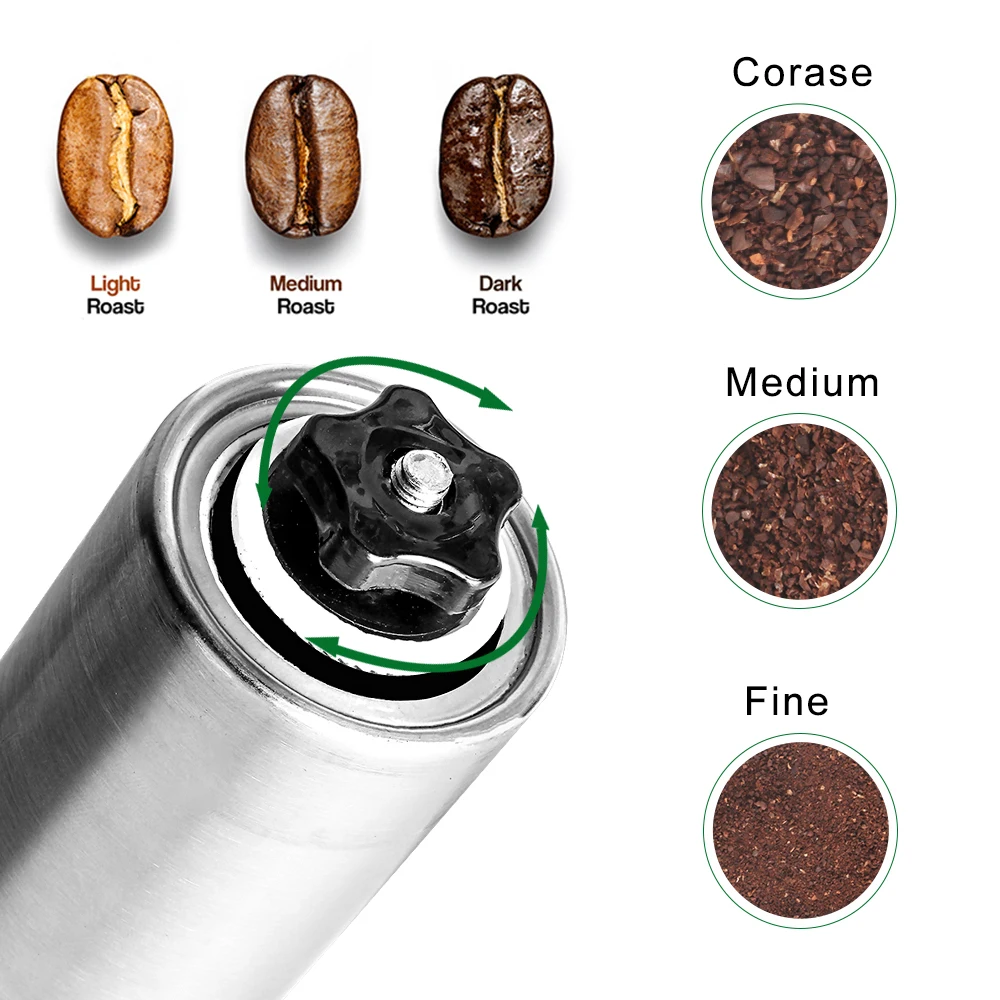
Ultralight Champion: Porlex Mini II
When every gram counts on long-distance backpacking trips, the Porlex Mini II emerges as our ultralight recommendation without sacrificing too much performance.
| Specification | Details |
|---|---|
| Weight | 8 oz (227g) |
| Dimensions | 5 × 1.8 inches (130 × 45mm) |
| Materials | Stainless steel body, ceramic burrs |
| Capacity | 0.7 oz (20g) |
| Grind Settings | Stepless |
The Porlex Mini II’s stainless steel body achieves remarkable lightness while maintaining necessary durability for trail conditions. At just 8 ounces, it’s among the lightest functional burr grinders available—a weight that compact coffee grinders for backpackers need to achieve.
The ceramic burrs produce a good, though not exceptional, grind consistency. You’ll get very acceptable results for most camping brewing methods, with medium-coarse settings being particularly strong. The finest settings show some inconsistency, making this less ideal for espresso enthusiasts.
What truly distinguishes the Porlex is its compact cylindrical design and removable handle that significantly reduces packed size. It easily slips into the corner of a backpack or even a large pocket. The grinding action requires slightly more effort than premium models but remains manageable.
The capacity matches the 1Zpresso Q2, providing enough grounds for one or two cups—perfect for the solo backpacker or ultralight duo.
Pros:
– Exceptionally lightweight
– Very compact packed size with removable handle
– Durable stainless steel construction
– Good grind consistency for medium to coarse settings
Cons:
– Less consistent at fine grind settings
– Requires more effort to grind
– Smaller capacity
For backpackers counting every ounce who still want freshly ground coffee on the trail, the Porlex Mini II delivers remarkable performance for its minimal weight penalty.
Best Value: Timemore Chestnut C2
The Timemore Chestnut C2 offers impressive performance at a mid-range price point, making it our value champion for campers watching their budget.
| Specification | Details |
|---|---|
| Weight | 15 oz (425g) |
| Dimensions | 5.9 × 2.1 inches (150 × 53mm) |
| Materials | Aluminum body, stainless steel burrs |
| Capacity | 0.9 oz (25g) |
| Grind Settings | 36 clicks |
The C2 surprises with grind quality that approaches much more expensive models. Its stainless steel burrs produce remarkably consistent grounds, especially at medium and coarse settings perfect for common camping brewing methods.
The aluminum body provides excellent durability for outdoor use while keeping the weight reasonable. Though slightly heavier than our ultralight pick, the C2 compensates with greater capacity and easier grinding.
The grind adjustment offers 36 distinct settings—fewer than premium options but still providing ample precision for dialing in your brew. The numbered clicks are easy to feel, allowing adjustment even in low light conditions common at campsites.
The ergonomic handle design makes grinding less fatiguing, an important consideration when you’re making coffee for multiple people or have limited morning energy at high elevation.
Pros:
– Excellent performance-to-price ratio
– Very good grind consistency
– Durable construction
– Comfortable grinding action
– Slightly larger capacity than ultralight options
Cons:
– Heavier than dedicated ultralight options
– Fewer adjustment settings than premium models
For campers seeking great coffee without breaking the bank, the Timemore C2 delivers exceptional value with minimal compromises.
Premium Pick: Comandante C40 MK4
For those who refuse to compromise on coffee quality regardless of location, the Comandante C40 MK4 represents the pinnacle of portable hand grinding performance.
| Specification | Details |
|---|---|
| Weight | 21 oz (595g) |
| Dimensions | 6.3 × 2.4 inches (160 × 60mm) |
| Materials | Stainless steel/wood, steel burrs |
| Capacity | 1.2 oz (35g) |
| Grind Settings | 40+ clicks |
The C40 is undeniably the heaviest option in our lineup, but it delivers grinding performance that matches or exceeds electric home grinders. The proprietary burr design produces exceptionally uniform particles across all grind settings, resulting in noticeably superior extraction and flavor clarity.
The build quality is unmatched among portable grinders. The combination of stainless steel, wood, and polymer components creates a handheld coffee grinder that can withstand years of outdoor adventures while maintaining consistent performance.
The larger capacity allows brewing for groups without multiple grinding sessions. The grinding action is remarkably smooth and efficient, requiring less time and effort than lighter models—an advantage when brewing for several people.
While the weight makes this impractical for ultralight backpacking, it’s perfectly suitable for car camping, base camping, overlanding, or short backpacking trips where coffee quality is prioritized over minimum weight.
Pros:
– Exceptional grind quality and consistency
– Superior build quality and durability
– Efficient grinding mechanism
– Larger capacity
– Excellent craftsmanship and aesthetics
Cons:
– Heaviest option reviewed
– Highest price point
– May be overkill for casual coffee drinkers
For coffee enthusiasts who view exceptional coffee as an essential part of their outdoor experience rather than a luxury, the Comandante justifies its weight and price through uncompromising performance.
Best for Car Camping: GSI Outdoors JavaMill
When vehicle space isn’t as limited, the GSI Outdoors JavaMill offers practical features specifically designed for the car camping experience.
| Specification | Details |
|---|---|
| Weight | 9.3 oz (264g) |
| Dimensions | 7.5 × 2.5 inches (190 × 64mm) |
| Materials | Plastic/silicone, ceramic burrs |
| Capacity | 1.1 oz (30g) |
| Grind Settings | Adjustable (non-stepped) |
The JavaMill’s clever design prioritizes convenience and stability. The silicone base prevents slipping during grinding—especially useful on camp tables or vehicle tailgates. The transparent body allows you to see the grinding progress and bean level.
While the ceramic burrs don’t match the consistency of premium metal options, they perform adequately for French press and pour-over brewing. The plastic construction keeps weight surprisingly low but isn’t as durable as metal alternatives for rugged backpacking use.
Where the JavaMill truly shines is in its user-friendly features. The larger grip provides excellent leverage, reducing effort during grinding. The wider opening makes filling with beans easier in camp conditions, and the grounds container minimizes spills.
Pros:
– Stable non-slip base
– Lightweight for its size
– Good ergonomics for easy grinding
– Higher capacity
– Budget-friendly price
Cons:
– Less consistent grind than premium options
– Plastic construction less durable for rough handling
– Bulkier packed size
For car campers who want fresh coffee without the investment in premium grinders, the JavaMill delivers a practical, affordable solution that focuses on campsite convenience.
Fine Adjustment Hand Grinder, Precision Manual Grinder, Travel Coffee Grinder
Price range: $185.11 through $494.63 Select options This product has multiple variants. The options may be chosen on the product pageHand Burr Grinder, Hand Crank Coffee Grinder, Manual Espresso Grinder, Portable Coffee Grinder
Price range: $262.72 through $300.22 Select options This product has multiple variants. The options may be chosen on the product pageCeramic Burr Coffee Grinder, Hand Burr Grinder, Hand Crank Coffee Grinder, Manual Coffee Bean Grinder
Price range: $59.17 through $59.96 Select options This product has multiple variants. The options may be chosen on the product pageHandheld Burr Grinder, Manual Coffee Mill Grinder, Travel Coffee Grinder
$191.45 Select options This product has multiple variants. The options may be chosen on the product pageManual Coffee Grinder Stainless Steel, Manual Espresso Grinder, Travel Coffee Grinder
Price range: $276.22 through $276.39 Select options This product has multiple variants. The options may be chosen on the product page
Grind Size Guide: Matching Your Camp Brewing Method
Getting the right grind size for your brewing method is crucial for delicious camp coffee. Use this guide to match your grinder settings to your preferred brewing method:
| Brewing Method | Grind Size | Visual Comparison | Typical Grinder Setting |
|---|---|---|---|
| AeroPress | Medium-fine to medium | Table salt | 12-18 clicks (medium) |
| Pour-over | Medium | Sand | 18-22 clicks (medium) |
| French press | Coarse | Sea salt | 24-30 clicks (coarse) |
| Moka pot | Fine | Sugar | 8-12 clicks (fine) |
| Cowboy coffee | Extra coarse | Peppercorns | 30+ clicks (coarsest) |
The right grind size directly impacts extraction. Too fine a grind for French press results in over-extraction and bitterness. Too coarse for pour-over leads to weak, under-extracted coffee.
Understanding the ultimate espresso grind size chart and adapting it to camping conditions helps you dial in perfect results. If your coffee tastes sour or weak, try a finer grind. If it’s bitter or harsh, go coarser.
Most quality grinders use “clicks” to measure settings. The numbers above are approximations—your specific grinder may vary. When in doubt, start in the middle of the recommended range and adjust based on taste.
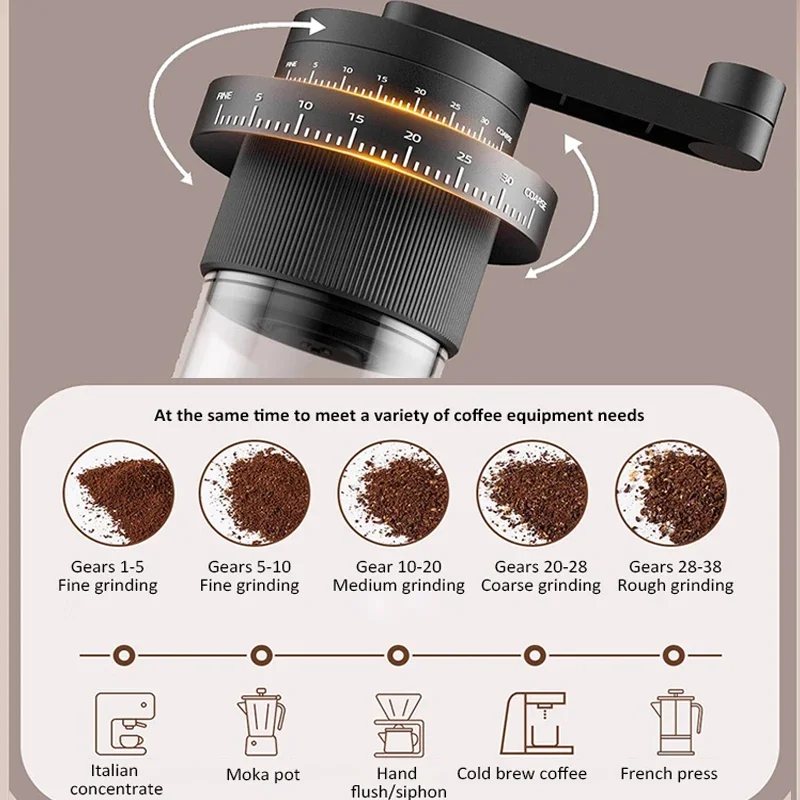
Practical Tips for Hand Grinding While Camping
Pre-measure your beans: Before your trip, portion coffee beans into small silicone bags or containers (20g per serving is typically ideal). This eliminates the need for a scale at camp and speeds up your morning routine.
Create a stable grinding platform: Find a flat rock or use your knee while seated. Some campers place the grinder between their feet while sitting for maximum stability.
Use proper technique: Hold the grinder with your non-dominant hand and turn the handle with your dominant hand. Maintain a consistent pace rather than rapid bursts for the most uniform results.
Protect your grinder: Store your grinder in a sock or small drawstring bag to prevent damage from other gear. For maximum protection, place it inside your cooking pot if space allows.
Minimize water for cleaning: After use, disassemble only as needed and tap out remaining grounds. A small brush (an old toothbrush works well) can clean burrs without water. Deep cleaning can wait until you return home.
Pack efficiently: Many manual grinders designed for AeroPress fit inside the brewer itself, saving valuable pack space.
Can You Use Electric Grinders When Camping?
While manual grinders are ideal for most camping situations, electric options occasionally make sense in specific scenarios:
Battery-powered grinders typically run for only 2-5 batches before needing recharging, making them impractical for extended trips away from power. Their grinding quality often doesn’t match good manual options despite weighing more.
Traditional electric grinders require 120V power sources, limiting them to developed campgrounds with electrical hookups. Some campers with portable power stations or vehicle power inverters can use compact electric grinders, but the power requirements (typically 100-200 watts) make this inefficient for battery systems.
Noise is another significant consideration—electric grinders can be disruptively loud in peaceful campgrounds, particularly during quiet morning hours when others may still be sleeping.
For these reasons, manual grinders remain the most practical, reliable option for most camping situations, combining independence from power sources with quiet operation and excellent portability.
How to Properly Clean Your Grinder in the Field
Maintaining your grinder during camping trips prevents stale coffee oils from affecting flavor and ensures consistent performance. Here’s how to clean effectively with minimal water:
Daily quick cleaning:
– Disassemble the grinder’s main components (no tools required for most models)
– Tap out remaining grounds onto a piece of paper or directly onto the ground
– Use a small brush to remove grounds from burrs and threads
– Wipe down exterior with a dry clothWhen water is available:
– Avoid submerging any parts
– Slightly dampen a cloth to wipe exterior surfaces
– Use a damp (not wet) cotton swab to clean hard-to-reach areas
– Allow all parts to dry completely before reassemblyPreventing issues:
– Keep the grinder in a sealed bag or container when not in use
– Avoid grinding extremely oily dark roasts when field cleaning options are limited
– Consider bringing small cleaning brushes specifically designed for cleaning manual coffee grinders
Upon returning home, perform a more thorough cleaning with mild soap, water, and complete disassembly according to the manufacturer’s guidelines.
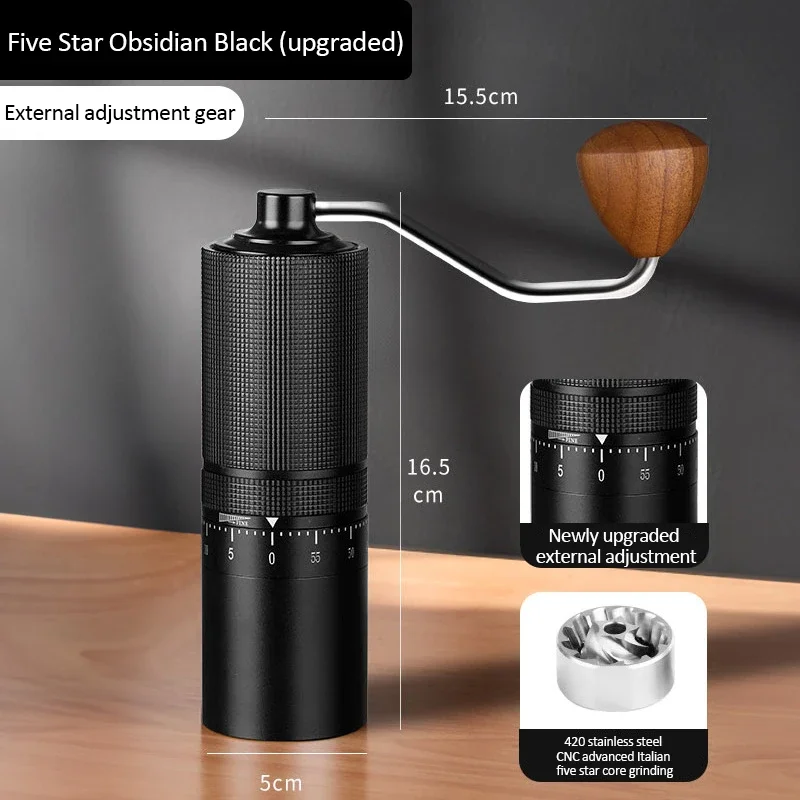
Are Ceramic or Steel Burrs Better for Camping?
The ceramic versus steel burr debate is particularly relevant for outdoor use where conditions differ from home environments:
Ceramic Burrs:
– Advantages: Lighter weight, won’t rust when exposed to moisture, generally less expensive
– Disadvantages: More brittle and can chip if dropped on hard surfaces, slightly less consistent grinding performance in some models
Steel Burrs:
– Advantages: More durable against impacts, typically produce more consistent grinds, longer-lasting edge retention
– Disadvantages: Slightly heavier, can potentially rust if not properly dried and maintained
For weekend warriors who camp occasionally, both options work well. However, for frequent outdoor use in demanding conditions, ceramic burr coffee grinders might be more practical if weight is your primary concern, while steel burrs offer superior performance and durability if you can accept a slight weight penalty.
Steel burrs generally perform better in cold conditions, while ceramic burrs are less affected by temperature changes. If your camping often involves freezing temperatures, this might influence your decision.
FAQs: Your Camping Coffee Grinder Questions Answered
How much does grind quality really matter in the field?
Grind consistency significantly impacts flavor even outdoors. Inconsistent grounds lead to both under-extraction (weak, sour) and over-extraction (bitter) simultaneously. Quality grinders produce noticeably better coffee, even with simple brewing methods like pour-over or French press.
What’s the absolute lightest grinder that still performs well?
At 8oz (227g), the Porlex Mini is among the lightest effective burr grinders. Some plastic models weigh slightly less but sacrifice significant performance and durability.
Can I grind enough for multiple people with these compact grinders?
Most portable grinders hold 20-30g of coffee (enough for 1-2 cups). For larger groups, you’ll need multiple grinding sessions. The Comandante C40’s larger capacity (35g) makes it better for groups of 2-3 people.
How long does it typically take to hand-grind coffee for one cup?
With quality grinders, grinding 20g (one cup) takes approximately 1-2 minutes depending on grind setting. Coarser grinds are faster, while finer grinds require more time and effort.
Are premium grinders worth the extra weight for weekend trips?
For weekend trips where weight isn’t critical, premium grinders offer noticeably better coffee with less effort. For longer backpacking trips where every ounce matters, lighter options make more sense despite performance trade-offs.
How do I protect my grinder from moisture and dirt?
Store your grinder in a sealed plastic bag or small stuff sack. For additional protection, some campers use silica gel packets in the storage container to absorb moisture.
Can I use these grinders for other purposes?
Most coffee grinders can handle spices like cumin or coriander, but avoid using the same grinder for both coffee and spices, as flavors will transfer. Some models struggle with very hard spices like cinnamon sticks or star anise.
The Final Grind: Elevating Your Outdoor Coffee Experience
There’s something deeply satisfying about mastering the art of excellent coffee in the wilderness. The simple pleasure of that first perfect sip while watching the sunrise over mountain peaks creates memories that last far longer than the caffeine buzz.
As we’ve explored, the right portable coffee grinder for camping makes all the difference in this experience. Whether you prioritize absolute performance, ultralight weight, or value, there’s a grinder that fits your specific outdoor coffee journey.
Remember that coffee in the outdoors isn’t just about the caffeine—it’s about creating moments of comfort and ritual in wild places. The extra effort of hand grinding fresh beans connects you more deeply to the process and enhances your appreciation of both the coffee and your surroundings.
Whatever your camping style—from ultralight backpacking to comfortable car camping—freshly ground coffee represents one of those small luxuries that delivers outsized rewards in pleasure and experience. Your perfect morning cup awaits somewhere out there in the wild.

